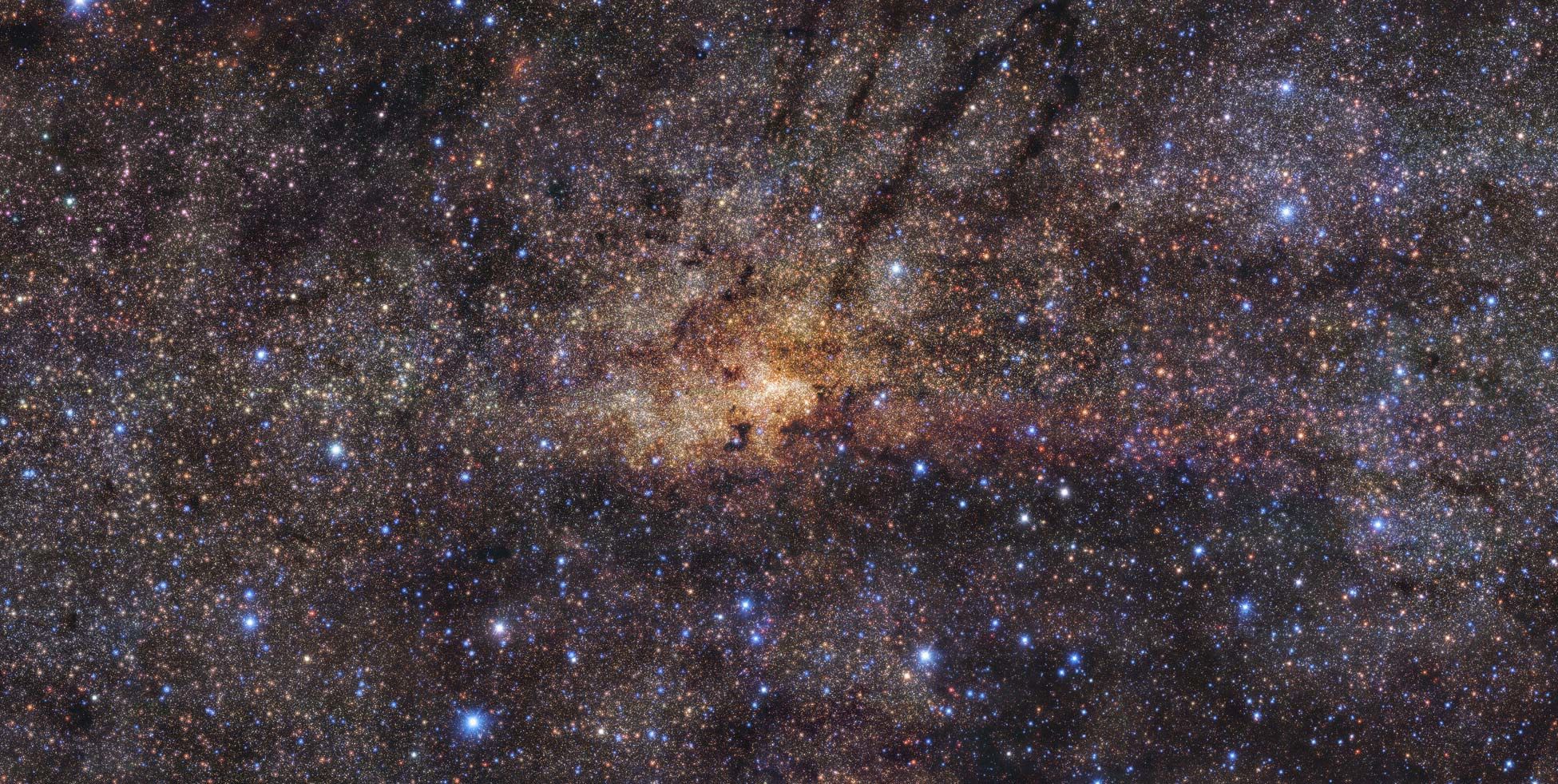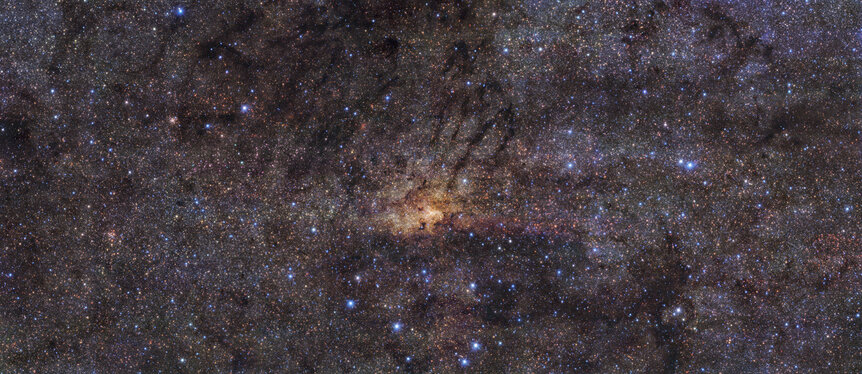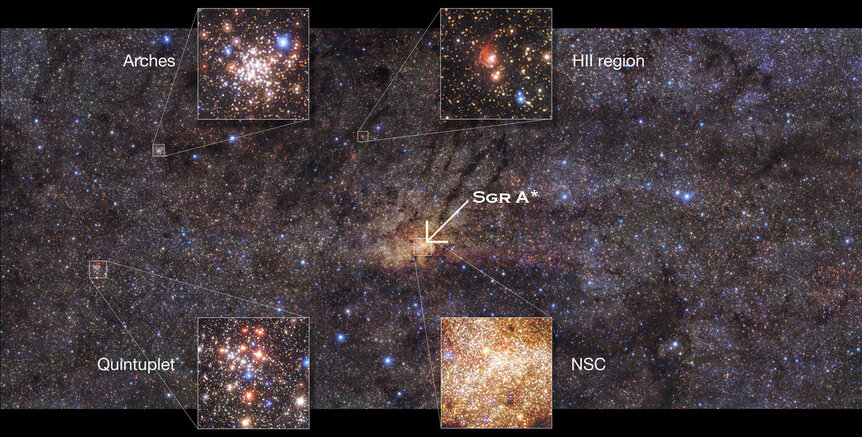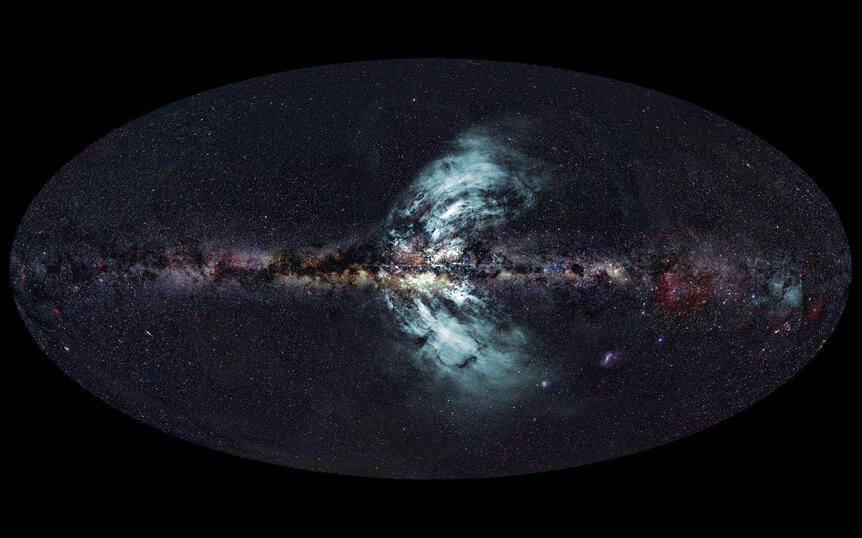Create a free profile to get unlimited access to exclusive videos, sweepstakes, and more!
A billion years ago the Milky Way had a huge burst of star birth

New results of a deep survey of stars that are in the very center of our Milky Way indicate that this part of our galaxy underwent a huge burst of star formation about a billion years ago. The implications of this study are fairly widespread, including implying that the supermassive black hole in the center of the galaxy gained most of its mass early on, that for that time the center of the galaxy outshone the rest of the galaxy, and that so many stars were exploding that on average there were as many in this tiny region as there were in the rest of the galaxy combined.
So, yeah.
The survey is called GALACTICNUCLEUS, and uses the extremely sensitive High Acuity Wide-field K-band Imager (or HAWK-I, get it?) on the massive Very Large Telescope in Chile. It mapped the exact center of our galaxy in near-infrared colors, which is important because there's so much gas and dust in the nucleus of the Milky Way that visible light has a tough time getting out. However, infrared light gets through more easily, so more stars can be seen. Also, the camera has incredible resolution, able to separate stars in crowded regions, which is also good because the center of the galaxy is basically shoulder-to-shoulder stars.
In the very center of the galaxy is a supermassive black hole, called Sgr A* (usually pronounced "Sagittarius A-star" or "Saj A-star" for short), which is far too small to see directly. But surrounding it is a disk of stars called the nuclear disk, and it's roughly 1,000 light years across. Despite the small size (the Milky Way is easily 100,000 light years across) it contains many billions of stars, and the history of those stars isn't well known. Did they all form at once, or was star formation constant over the 13 billion year history of the galaxy? One goal of the survey was to investigate this disk.
In all the survey mapped the infrared colors (different wavelengths of infrared light, just like the colors we see are different wavelengths of visible light) of over 3 million stars, and about 700,000 were used for this new research. The reason the colors are important is that when you compare the colors of the stars trends start to emerge, and you can separate out stars that, for example, are older, younger, more massive, lower mass, hotter, cooler, and so on.
When they did this they got a big surprise: They found two populations of stars there, some younger and some older. They then used models of how stars are born (that is, given a certain amount of gas that can form stars, how many will be high mass, how many will be medium, how many low mass, and so on) and how each one changes over time to try to match the observational results.
What they found is that the best fit to the data is that most (80%) of the stars in the nuclear disk are very old, forming from 8 to 13.5 billion years ago, which means some of them were among the first stars to form in the Milky Way. After that things settled down, and star formation was relatively quiet for the next 6 or so billion years.
Then, about 600 million to a billion years ago, the nuclear disk underwent a massive burst of star formation. The rate at which stars were made skyrocketed, and for about 100 million years our galactic center was quite fecund. So many stars were made in that short time that they totaled about 5% of the mass of stars in the nuclear disk.
On average, in our galaxy stars are born at a rate of about 1 solar mass (the mass of the Sun) per year. That doesn't mean one star like the Sun is churned out every year; it's an average over a long time. Also, most stars in the galaxy are low mass (around 0.1 to ½ the mass of the Sun) so in reality a few stars are born every year on average.
During that burst of star formation in the nucleus, and despite being maybe 1% of the total volume of the galaxy, the rate of star formation there equaled that of the rest of the galaxy around it! That's a lot of stars being born packed into a small region.
Also, a lot of the stars born in this burst would have been high-mass stars, ones that are very luminous, tear through their fuel rapidly, and explode as supernovae after only a few million years. Given the rate of star birth, they find that there must have been at least 200,000 supernovae during that 100 million year period! That's about the same rate (one every few centuries) as the rest of the galaxy combined. Oof.
They also note that there are two huge bubbles of extremely high-energy gas erupting from the Milky Way's core right now, called Fermi Bubbles. Astronomers have argued that this was either the combined wind from lots of exploding stars, or could be due to the wind from the sheer number of stars in the galactic center. Research from a few years ago indicated the latter, but the new work indicates that the supernovae from the starburst are enough to power the bubbles on their own.
There's an interesting conclusion to be made about when the disk wasn't making stars, too. Supermassive black holes grow as gas pours in from the galaxy into its core. Given that there was a long quiet period of billions of years before the starburst — meaning that the central part of the galaxy was starved of gas — this in turn means Sgr A* must have grown to about its current size early on in the history of the galaxy. We know that galaxies and their central supermassive black holes profoundly affect each other's growth, so this also gives us some insight into the history of the galaxy as a whole.
These results are actually quite a surprise. It was thought that the nuclear disk of the galaxy formed stars pretty steadily over the last 13 or so billion years, but this new work indicates it was hot and heavy for a while, then quiet, then (for a short time relatively speaking) kablam! It also contradicts the stellar wind model of how the Fermi Bubbles formed.
I'll note though that these results also do kinda sorta jibe with other recent work that shows that the galaxy overall had a burst of star formation a couple of billion years ago. These usually happen when a big galaxy like ours collides with and merges with a smaller one (or there's a near miss which disturbs the big galaxy enough that gas clouds collide and star birth increases), and there are other indications this may have happened around that time. It's possible the nuclear disk star birth burst is related to that.
It's hard to say how firm these results are. The fact that they contradict other ideas isn't necessarily a mark against them, but it should raise some healthy skepticism. Happily, in the paper the authors say the data will be publicly available later this year. I can imagine a lot of astronomers will jump on this opportunity and work on the observations themselves. I'd love to know how that turns out. If these results hold up it means a better and deeper understanding of the central region of the Milky Way, which, though small in volume, has an outsized effect on the rest of our sprawling galaxy.





























